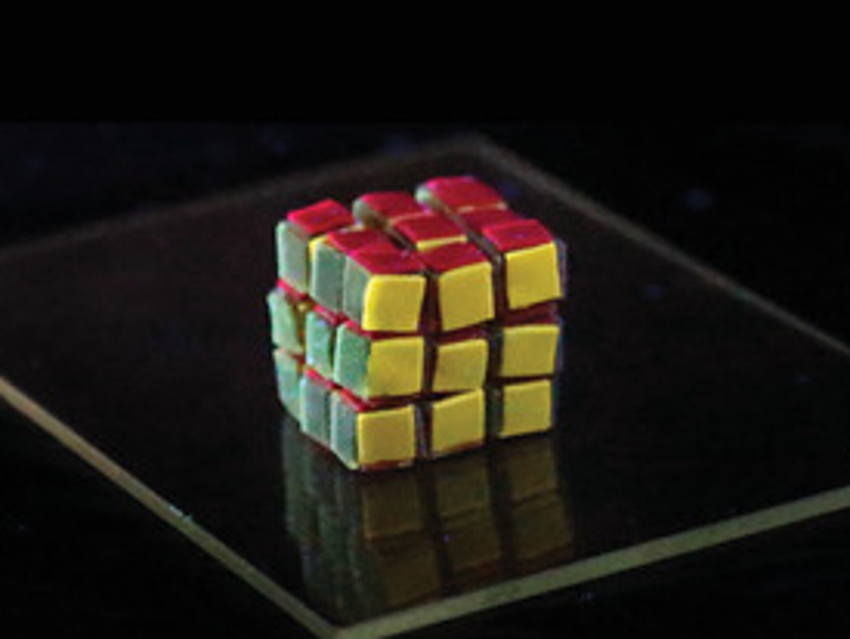Most people know the Rubik’s Cube, a three-dimensional puzzle toy where blocks are arranged into a large cube with differently colored faces. Rotating one layer of blocks alters the color pattern of the cube’s faces. Jonathan L. Sessler, The University of Texas at Austin, USA, Ben Zhong Tang, The Hong Kong University of Science and Technology (HKUST), China, and South China University of Technology, Guangzhou, and colleagues have prepared a fully functional mimic of Rubik’s Cube, with all 27 blocks made of a soft hydrogel. No mechanical locks stabilize the parts—they stick together only by chemical interactions.
The Material
The researchers were interested in creating three-dimensional patterns that can be used to encode and store information. A very famous three-dimensional patterned structure is that of the Rubik’s Cube, and its appealing qualities as a mathematical toy inspired the scientists to reconstruct it using hydrogel blocks.
Hydrogels are polymeric networks that contain a lot of water as part of their structure. They are squishy and soft, and some types can even heal themselves after damage. Self-healing largely depends on the reactions that crosslink the polymer strands: if they are close to equilibrium, new bonds can form after old ones are broken.
The scientists prepared a hydrogel with dynamic covalent linkages by reacting two poly(ethylene glycol)-based polymers, one was a linear type with benzoyl hydrazine groups at both ends, the other polymer contained a branched structure with four poly(ethylene glycol) chains all connected at one end and bearing a benzaldehyde group at the other end. The crosslinking proceeded via a reaction of the benzoyl hydrazine end of the linear polymer with the benzaldehyde groups of the branched one to form acylhydrazone linkages.
Hierarchical Adhesion
Using this reaction, the scientists prepared hydrogel blocks equal in size to the blocks of the original Rubik’s Cube. Then they put on the colored faces: On each face of the hydrogel blocks, slices of the same basic hydrogel were attached, but this time prepared in the presence of aggregation-induced emission (AIE) dots. These AIE dots are pigments that intensify their fluorescent emission in solute environments as those provided by the gel. Under UV light, the block’s faces glowed intensively in blue, yellow, green, red, and orange.
Twenty-seven of these cubes were put together to form a complete, soft Rubik’s Cube mimic. They stuck together because the dynamic crosslinking reactions caused adhesive forces, the team explained: When two blocks surfaces came into contact, the end groups of the polymer strands poking out of the surfaces reacted to form new hydrazone linkages. The longer the surfaces were left reacting, the more joints were made and the higher was the “stickiness” between the hydrogel blocks, according to the team.
This dynamic covalent behavior made a kind of hierarchical adhesion possible. First, the fluorescing surfaces were tightly attached to the individual blocks by a 24-hour-long reaction. “This allowed for robust adhesion between the core hydrogel and the colored faces”, the team reported. In contrast, the whole cube was assembled by only one hour of curing. The shorter period ensured a weaker adhesion between the blocks, which could still be removed or shifted against each other mechanically, but the whole cube did not fall apart when touched or shaken (gently).
Not Just a Toy
The cube proved functional: Like the original hard-plastic version, the soft-block layers could be rotated relative to each other, changing the color pattern of the faces. But it had other features. As there was no rigid lever or lock in this one-material version, blocks could be taken out, rotated, and re-inserted to create a different color pattern without physically damaging the system. And dyes could be used that respond to chemical stimuli. This would allow for further, nonmechanical manipulations of the color patterns, the researchers argued.
This soft and variable Rubik’s Cube structure “could have potential applications in areas where pattern-dependent behavior could prove beneficial,” the team concluded. Another, more fundamental aspect is that the scientists further explored dynamic covalent linkage systems to assemble functional macrostructures—to create, for example, fascinating puzzle toys.
- A Functioning Macroscopic “Rubik’s Cube” Assembled via Controllable Dynamic Covalent Interactions,
Xiaofan Ji, Zhao Li, Xiaolin Liu, Hui‐Qing Peng, Fengyan Song, Ji Qi, Jacky W. Y. Lam, Lingliang Long, Jonathan L. Sessler, Ben Zhong Tang,
Adv. Mater. 2019.
https://doi.org/10.1002/adma.201902365



